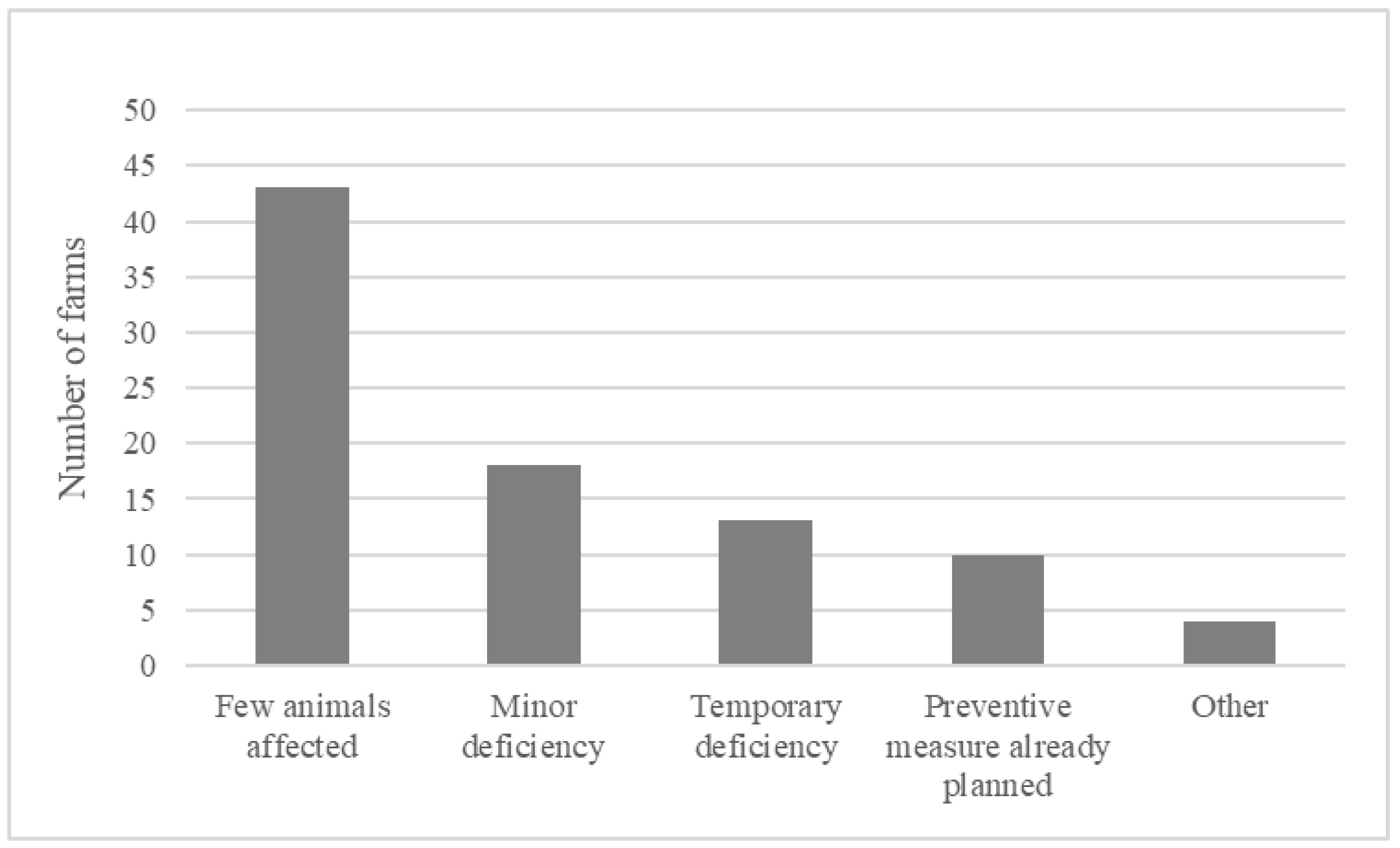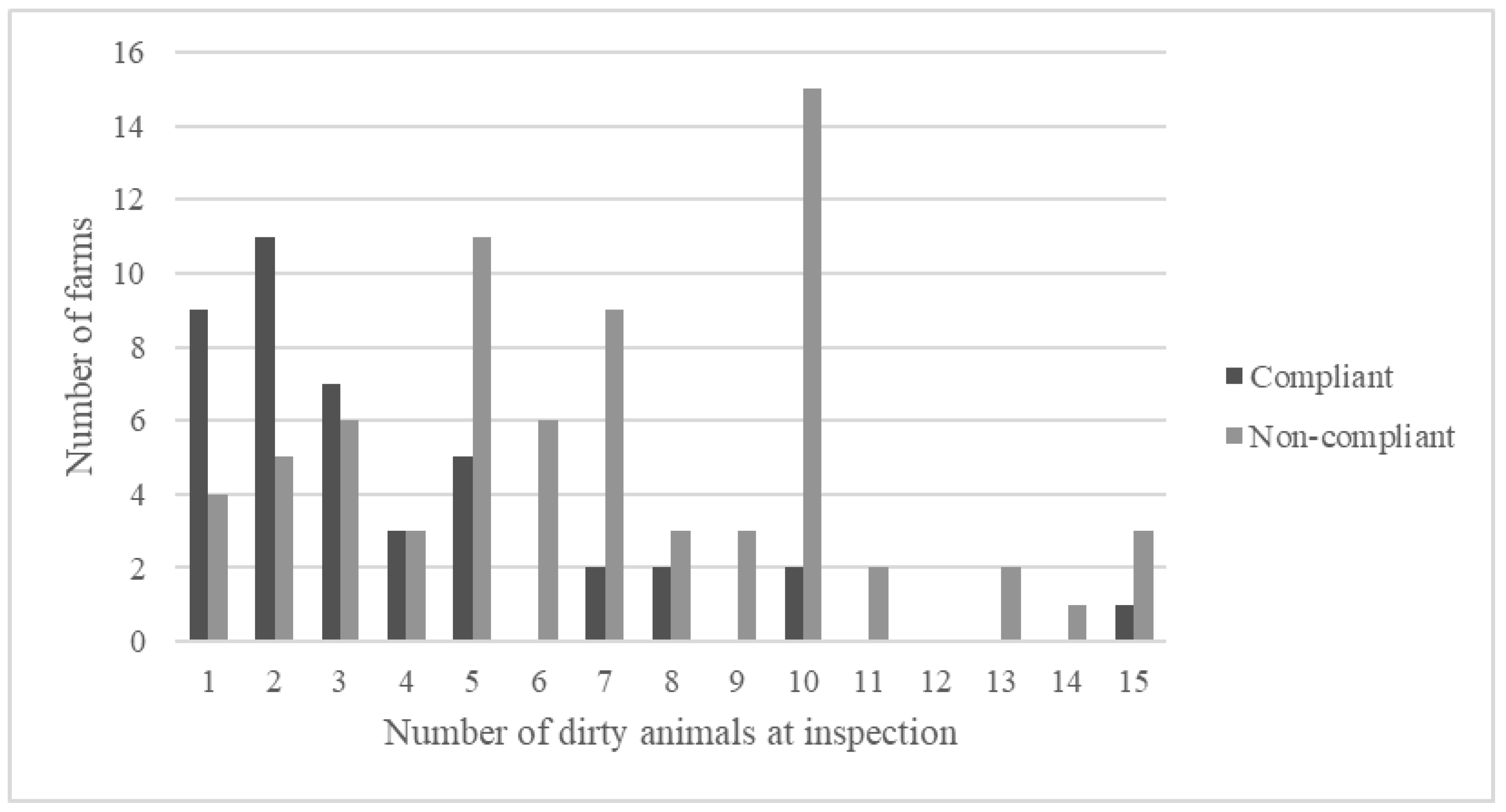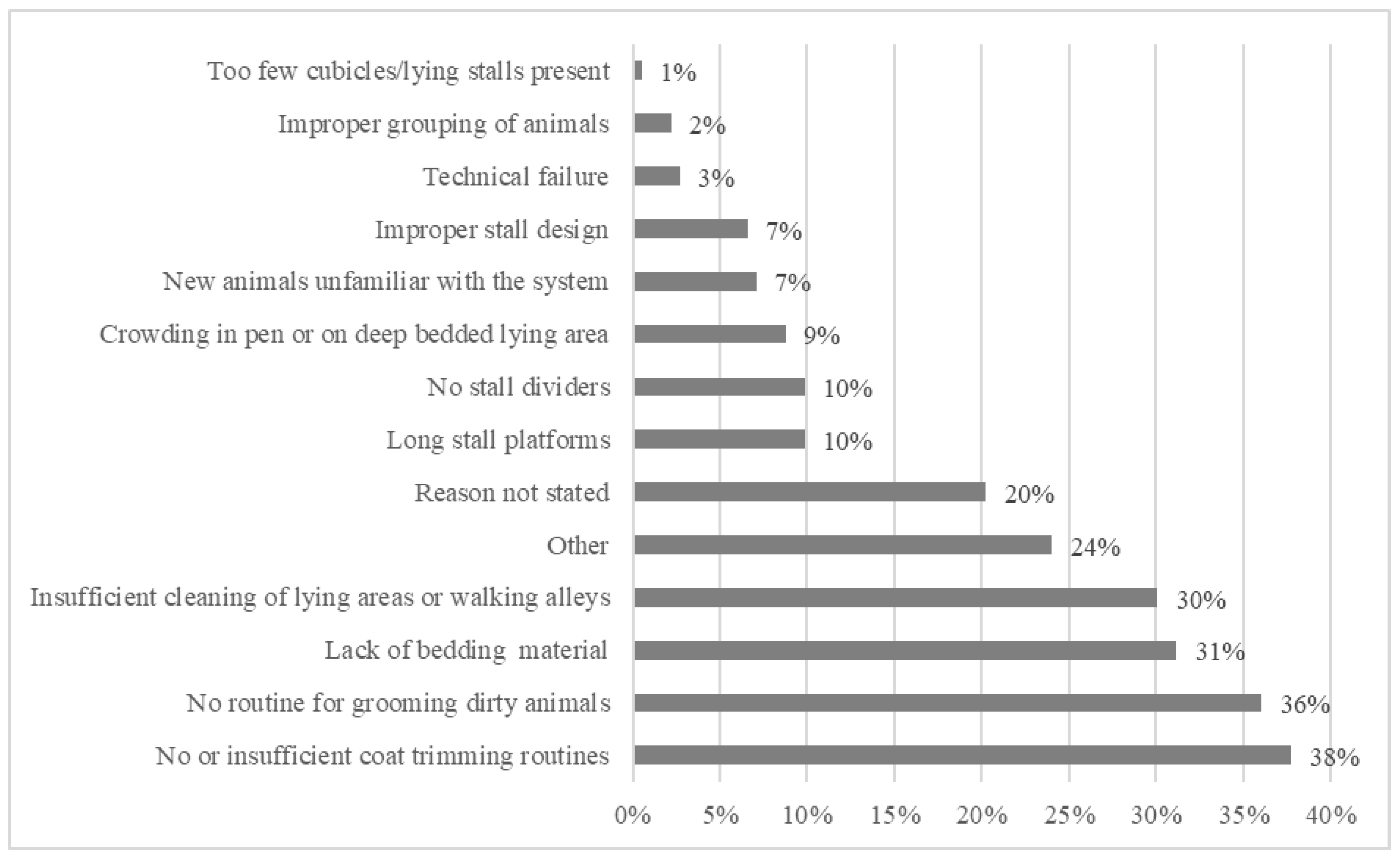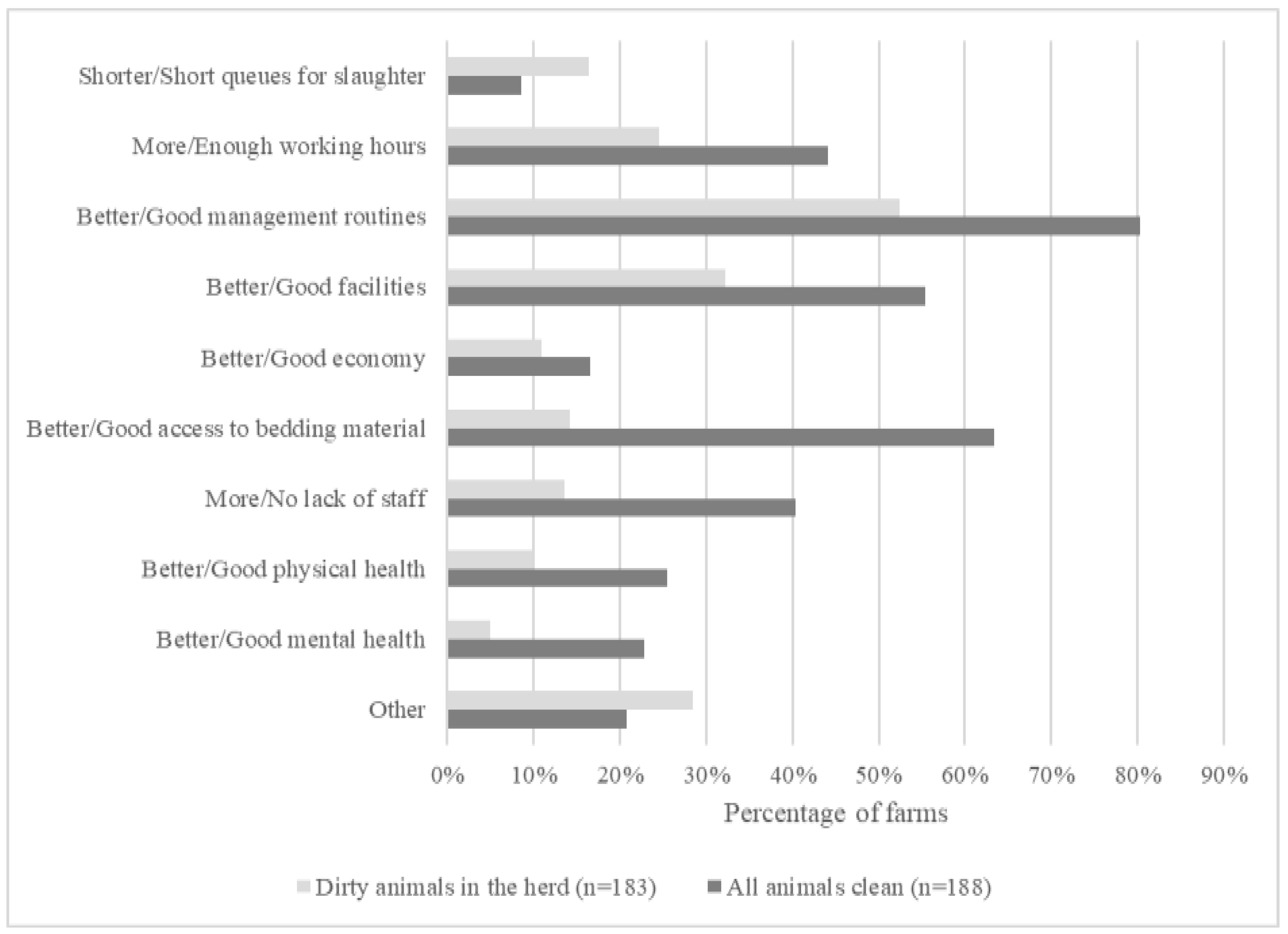Cattle Cleanliness from the View of Swedish Farmers and Official Animal Welfare Inspectors
Abstract
Simple Summary
Abstract
1. Introduction
Aim
2. Material and Methods
3. Results
3.1. Types of Farms and Inspections
3.2. Number of Dirty Animals and Legal Compliance on Animal Cleanliness
3.3. Reasons for Having Dirty Animals in the Herd
3.4. Farmers’ Needs and Keys to Success in Keeping Cattle Clean
4. Discussion
4.1. Dirty Cattle Is Common
4.2. Challenges in Interpretation and Assessment
4.3. Actions and Attitudes
5. Conclusions
Supplementary Materials
Author Contributions
Funding
Institutional Review Board Statement
Data Availability Statement
Conflicts of Interest
References
- Swedish Board of Agriculture. Djurskyddskontrollen 2019—En Redovisning Av Länsstyrelsernas Arbete [The Official Animal Welfare Control 2019—The Work of the County Administrative Boards]; Swedish Board of Agriculture: Jönköping, Sweden, 2020; pp. 1–82.
- Keeling, L.J. An analysis of animal-based versus resource-based comments in official animal welfare inspection reports from organic and conventional farms in Sweden. Anim. Welf. 2009, 18, 391–397. [Google Scholar]
- Lundmark Hedman, F.; Hultgren, J.; Röcklinsberg, H.; Wahlberg, B.; Berg, C. Non-compliance and follow-up in Swedish official and private animal welfare control of dairy cows. Animals 2018, 8, 72. [Google Scholar] [CrossRef] [PubMed]
- Väärikkälä, S.; Koskela, T.; Hänninen, L.; Nevas, M. Evaluation of criminal sanctions concerning violations of cattle and pig welfare. Animals 2020, 10, 715. [Google Scholar] [CrossRef]
- Ruud, L.; Bøe, K.; Østerås, O. Risk factors for dirty dairy cows in Norwegian freestall systems. J. Dairy Sci. 2010, 93, 5216–5224. [Google Scholar] [CrossRef]
- Costa, J.H.; Burnett, T.A.; Von Keyserlingk, M.A.; Hötzel, M.J. Prevalence of lameness and leg lesions of lactating dairy cows housed in southern Brazil: Effects of housing systems. J. Dairy Sci. 2018, 101, 2395–2405. [Google Scholar] [CrossRef] [PubMed]
- Verdes, S.; Trillo, Y.; Peña, A.I.; Herradón, P.G.; Becerra, J.J.; Quintela, L.A. Relationship between quality of facilities, animal-based welfare indicators and measures of reproductive and productive performances on dairy farms in the northwest of Spain. Ital. J. Anim. Sci. 2020, 19, 319–329. [Google Scholar] [CrossRef]
- Mullan, S.; Bunglavan, S.J.; Rowe, E.; Barrett, D.C.; Lee, M.R.F.; Ananth, D.; Tarlton, J. Welfare Challenges of Dairy Cows in India Identified Through On-Farm Observations. Animals 2020, 10, 586. [Google Scholar] [CrossRef]
- Broom, D.M. Animal Welfare in the European Union; Study for the PETI Committee; European Parliament: Brussels, Belgium, 2017; Available online: https://op.europa.eu/sv/publication-detail/-/publication/74df7b49-ffe7-11e6-8a35-01aa75ed71a1/language-en (accessed on 10 February 2021).
- European Commission. Overview Report: Welfare of Cattle on Dairy Farms; DG Health and Food Safety, Publications Office of the European Union: Luxembourg, 2017. [Google Scholar]
- Lundmark, F.; Röcklinsberg, H.; Wahlberg, B.; Berg, C. Content and structure of Swedish animal welfare legislation and private standards for dairy cattle. Acta Agric. Scand. Sect. A Anim. Sci. 2016, 66, 35–42. [Google Scholar] [CrossRef]
- SJVFS 2019:18. Statens Jordbruksverks Föreskrifter och Allmänna Råd om Nötkreaturshållning inom Lantbruket m.m. [The Swedish Board of Agriculture’s Regulations and General Recommendations on Cattle in Agriculture etc.]; The Swedish Board of Agriculture: Jönköping, Sweden, 2019.
- Munoz, M.; Bennett, G.; Ahlström, C.; Griffiths, H.; Schukken, Y.; Zadoks, R. Cleanliness scores as indicator of klebsiella exposure in dairy cows. J. Dairy Sci. 2008, 91, 3908–3916. [Google Scholar] [CrossRef] [PubMed]
- Breen, J.E.; Green, M.J.; Bradley, A.J. Quarter and cow risk factors associated with the occurrence of clinical mastitis in dairy cows in the United Kingdom. J. Dairy Sci. 2009, 92, 2551–2561. [Google Scholar] [CrossRef]
- Ellis, A.K.; Innocent, G.T.; Mihm, M.; Cripps, P.; McLean, W.G.; Howard, C.V.; Grove-White, D. Dairy cow cleanliness and milk quality on organic and conventional farms in the UK. J. Dairy Res. 2007, 74, 302–310. [Google Scholar] [CrossRef] [PubMed]
- Sant’Anna, A.; Da Costa, M.P. The relationship between dairy cow hygiene and somatic cell count in milk. J. Dairy Sci. 2011, 94, 3835–3844. [Google Scholar] [CrossRef]
- Manzi, M.D.P.; Nóbrega, D.B.; Faccioli, P.Y.; Troncarelli, M.Z.; Menozzi, B.D.; Langoni, H. Relationship between teat-end condition, udder cleanliness and bovine subclinical mastitis. Res. Vet. Sci. 2012, 93, 430–434. [Google Scholar] [CrossRef]
- EFSA. Scientific report on the effects of farming systems on dairy cow welfare and disease. EFSA J. 2009, 1143, 1–284. [Google Scholar]
- Nafstad, O. Skader og kvalitetsfeil på norske storfehuder. Norsk Veterinærtidsskrift 1999, 111, 311–319. (In Swedish) [Google Scholar]
- Barrientos, A.K.; Chapinal, N.; Weary, D.M.; Galo, E.; von Keyserlingk, M.A.G. Herd-level risk factors for hock injuries in free-stall-housed dairy cows in the northeastern United States and California. J. Dairy Sci. 2013, 96, 3758–3765. [Google Scholar] [CrossRef] [PubMed]
- Kester, E.; Holzhauer, M.; Frankena, K. A descriptive review of the prevalence and risk factors of hock lesions in dairy cows. Vet. J. 2014, 202, 222–228. [Google Scholar] [CrossRef] [PubMed]
- Hauge, S.J.; Nesbakken, T.; Moen, B.; Røtterud, O.-J.; Dommersnes, S.; Nesteng, O.; Østensvik, Ø.; Alvseike, O. The significance of clean and dirty animals for bacterial dynamics along the beef chain. Int. J. Food Microbiol. 2015, 214, 70–76. [Google Scholar] [CrossRef]
- Fulwider, W.; Grandin, T.; Garrick, D.; Engle, T.; Lamm, W.; Dalsted, N.; Rollin, B. Influence of free-stall base on tarsal joint lesions and hygiene in dairy cows. J. Dairy Sci. 2007, 90, 3559–3566. [Google Scholar] [CrossRef]
- Andreasen, S.; Forkman, B. The welfare of dairy cows is improved in relation to cleanliness and integument alterations on the hocks and lameness when sand is used as stall surface. J. Dairy Sci. 2012, 95, 4961–4967. [Google Scholar] [CrossRef]
- de Vries, M.; Bokkers, E.A.M.; van Reenen, C.G.; Engel, B.; van Schaik, G.; Dijkstrad, T.; de Boer, I.J.M. Animal housing and management factors associated with indicators of dairy cattle welfare. Prev. Vet. Med. 2015, 118, 80–92. [Google Scholar] [CrossRef]
- Fregonesi, J.; Von Keyserlingk, M.; Tucker, C.; Veira, D.; Weary, D. Neck-rail position in the free stall affects standing behavior and udder and stall cleanliness. J. Dairy Sci. 2009, 92, 1979–1985. [Google Scholar] [CrossRef] [PubMed]
- Veissier, I.; Capdeville, J.; Delval, E. Cubicle housing sys-tems for cattle: Comfort of dairy cows depends on cubicle adjustment. J. Anim. Sci. 2004, 82, 3321–3337. [Google Scholar] [CrossRef] [PubMed]
- Nielsen, B.H.; Thomsen, P.T.; Sørensen, J.T. Identifying risk factors for poor hind limb cleanliness in Danish loose-housed dairy cows. Animals 2011, 5, 1613–1619. [Google Scholar] [CrossRef] [PubMed]
- Hanna, A.; Sneddon, V.; Beattie, E. The relationship between the stockperson’s personality and attitudes and the productivity of dairy cows. Animal 2009, 3, 737–743. [Google Scholar] [CrossRef] [PubMed]
- Hemsworth, P.H.; Coleman, G.J.; Barnett, J.L.; Borg, S.; Dowling, S. The effects of cognitive behavioral intervention on the at-titude and behavior of stockpersons and the behavior and productivity of commercial dairy cow. J. Anim. Sci. 2002, 80, 68–78. [Google Scholar] [CrossRef]
- Swedish Board of Agriculture. Vägledning för Kontrollmyndigheter m.fl.–Bilaga Nötkreatur [Guidelines for Official Control Authorities and Others—Appendix Cattle]; Swedish Board of Agriculture: Jönköping, Sweden, 2018.
- Swedish Board of Agriculture. Tillfredsställande Rent Nötkreatur [A Cattle Being Clean Enough]; Notes from 21 February 2021; Swedish Board of Agriculture: Jönköping, Sweden, 2020; pp. 1–2.
- Swedish Board of Agriculture. Jordbruksverkets Statistikdatabas [The Swedish Board of Agriculture’s Statistical Database]. Available online: https://jordbruksverket.se/om-jordbruksverket/jordbruksverkets-officiella-statistik (accessed on 3 February 2021).
- Popescu, S.; Borda, C.; Diugan, E.A.; Spînu, M.; Groza, I.S.; Sandru, C.D. Dairy cows welfare quality in tie-stall housing system with or without access to exercise. Acta Vet. Scand. 2013, 55, 43. [Google Scholar] [CrossRef]
- Swedish Board of Agriculture. Krav På Att Hålla Djur Lösgående [Requirements to Keep Animals Loose-Housed]; Report 2019:17; Swedish Board of Agriculture: Jönköping, Sweden, 2019.
- European Commission. Communication from the Commission to the European Parliament, the Council and the European Economic and Social Committee on the European Union Strategy for the Protection and Welfare of Animals 2012–2015; European Commission: Brussels, Belgium, 2012. [Google Scholar]
- EFSA. EFSA Panel on Animal Health and Welfare (AHAW) scientific opinion on the use of animal-based measures to assess welfare of dairy cows. EFSA J. 2012, 10, 2554. [Google Scholar] [CrossRef]
- Main, D.; Mullan, S.; Atkinson, C.; Cooper, M.; Wrathall, J.; Blokhuis, H. Best practice framework for animal welfare certification schemes. Trends Food Sci. Technol. 2014, 37, 127–136. [Google Scholar] [CrossRef]
- Tonsor, G.T.; Olynk, N.J. Impacts of animal well-being and welfare media on meat demand. J. Agric. Econ. 2011, 62, 59–72. [Google Scholar] [CrossRef]
- Swedish Board of Agriculture. Jordbruksverkets Djurskyddsstrategi [The Swedish Board of Agriculture’s Strategy on Animal Welfare]; Swedish Board of Agriculture: Jönköping, Sweden, 2020; pp. 1–6.
- Blokhuis, H.; Miele, M.; Veissier, I.; Jones, B. (Eds.) Improving Farm Animal Welfare. Science And Society Working Together: The Welfare Quality Approach; Wageningen Academic Publishers: Wageningen, The Netherlands, 2013; pp. 1–232. [Google Scholar]
- Lundmark, F.; Berg, C.; Wahlberg, B.; Röcklinsberg, H. ‘One animal is no animal’—Consequences of measuring animal welfare at herd level. In Know Your Food—Food Ethics and Innovation; Dumitras, D.E., Jitea, I.M., Aerts, S., Eds.; Wageningen Academic Publishers: Wageningen, The Netherlands, 2015; pp. 31–35. [Google Scholar]
- Lomellini-Dereclenne, A.C.; Miele, M.; Mounier, L.; Veissier, I. Implementation of the European legislation to protect farm an-imals: A case study on French inspections to find solutions to improve compliance. Anim. Welf. 2017, 26, 311–321. [Google Scholar] [CrossRef]
- Anneberg, I.; Vaarst, M.; Sandøe, P. To inspect, to motivate or to do both? A dilemma for on-farm inspection of animal welfare. Anim. Welf. 2013, 22, 185–194. [Google Scholar] [CrossRef]
- Viksten, S.M.; Visser, E.K.; Blokhuis, H.J. A comparative study of the application of two horse welfare assessment protocols. Acta Agric. Scand. Sect. A Anim. Sci. 2016. [Google Scholar] [CrossRef]
- Schindler, S. The animal’s dignity in Swiss Animal Welfare Legislation—Challenges and opportunities. Eur. J. Pharm. Biopharm. 2013, 84, 251–254. [Google Scholar] [CrossRef]
- Johansson, V. Tillsyn och Effektivitet [Control and Efficiency]; Boréa Bokförlag: Umeå, Sweden, 2006; pp. 1–230. [Google Scholar]
- De Vries, M.; Bokkers, E.; Van Schaik, G.; Botreau, R.; Engel, B.; Dijkstra, T.; De Boer, I. Evaluating results of the welfare quality multi-criteria evaluation model for classification of dairy cattle welfare at the herd level. J. Dairy Sci. 2013, 96, 6264–6273. [Google Scholar] [CrossRef]
- Bokkers, E.; De Vries, M.; Antonissen, I.; De Boer, I. Inter- and intra-observer reliability of experienced and inexperienced observers for the Qualitative Behaviour Assessment in dairy cattle. Anim. Welf. 2012, 21, 307–318. [Google Scholar] [CrossRef]
- Vasseur, E.; Gibbons, J.; Rushen, J.; De Passillé, A. Development and implementation of a training program to ensure high repeatability of body condition scoring of dairy cows. J. Dairy Sci. 2013, 96, 4725–4737. [Google Scholar] [CrossRef]
- EFSA. Statement on the use of animal-based measures to assess the welfare of animals. EFSA J. 2012, 10, 1–29. [Google Scholar]
- Keeling, L.; Evans, A.; Forkman, B.; Kjaernes, U. Welfare quality(R) principles and criteria. In Improving Farm Animal Welfare—Science and Society Working Together: The Welfare Quality Approach; Blokhuis, H.J., Jones, R.B., Veissier, I., Miele, M., Eds.; Wageningen Academic Publishers: Wageningen, The Netherlands, 2013; pp. 91–114. [Google Scholar]
- Larsson, B.S.; Petersson, E.; Stéen, M.; Hultgren, J. Visual assessment of body condition and skin soiling in cattle by professionals and undergraduate students using photo slides. Acta Agric. Scand. Sect. A Anim. Sci. 2021, 70, 31–40. [Google Scholar] [CrossRef]
- Annen, D.N.; Wieck, C.; Kempen, M. Evaluation of minimum animal welfare conditions in national standards and farm certi-fication schemes for pig fattening. Acta Agric. Scand. Sect. A Anim. Sci. 2011, 61, 40–54. [Google Scholar]
- Lundmark, F.; Berg, C.; Röcklinsberg, H. Private animal welfare standards—Opportunities and risks. Animals 2018, 8, 4. [Google Scholar] [CrossRef]
- Westin, R.; Vaughan, A.; De Passillé, A.; Devries, T.; Pajor, E.; Pellerin, D.; Siegford, J.; Witaifi, A.; Vasseur, E.; Rushen, J. Cow- and farm-level risk factors for lameness on dairy farms with automated milking systems. J. Dairy Sci. 2016, 99, 3732–3743. [Google Scholar] [CrossRef]
- Jewell, M.; Cameron, M.; Spears, J.; McKenna, S.; Cockram, M.; Sanchez, J.; Keefe, G. Prevalence of hock, knee, and neck skin lesions and associated risk factors in dairy herds in the Maritime Provinces of Canada. J. Dairy Sci. 2019, 102, 3376–3391. [Google Scholar] [CrossRef] [PubMed]
- Jensen, P.; Recén, B.; Ekesbo, I. Preference of loose housed dairy cows for two different cubicle floor coverings. Swed. J. Agric. Res. 1988, 18, 141–146. [Google Scholar]
- O’Connell, J.M.; Meaney, W.J. Comparison of shredded newspaper and sawdust as bedding for dairy cows: Behavioural, clinical and economic parameters. Ir. Vet. J. 1997, 50, 167–170. [Google Scholar]
- Fregonesi, J.; Veira, D.; Von Keyserlingk, M.; Weary, D. Effects of bedding quality on lying behavior of dairy cows. J. Dairy Sci. 2007, 90, 5468–5472. [Google Scholar] [CrossRef]
- Reich, L.; Weary, D.; Veira, D.; Von Keyserlingk, M. Effects of sawdust bedding dry matter on lying behavior of dairy cows: A dose-dependent response. J. Dairy Sci. 2010, 93, 1561–1565. [Google Scholar] [CrossRef]
- Schütz, K.; Cave, V.; Cox, N.; Huddart, F.; Tucker, C. Effects of 3 surface types on dairy cattle behavior, preference, and hygiene. J. Dairy Sci. 2019, 102, 1530–1541. [Google Scholar] [CrossRef]
- Gebremedhin, K.G.; Cramer, C.O.; Larsen, H.J. Preference of dairy cattle for stall options in free stall housing. Trans. ASAE 1985, 28, 1637–1640. [Google Scholar] [CrossRef]
- Fisher, A.; Stewart, M.; Verkerk, G.; Morrow, C.; Matthews, L. The effects of surface type on lying behaviour and stress responses of dairy cows during periodic weather-induced removal from pasture. Appl. Anim. Behav. Sci. 2003, 81, 1–11. [Google Scholar] [CrossRef]
- Munksgaard, L.; Ingvartsen, K.L.; Pedersen, L.J.; Nielsen, V.K.M. Deprivation of lying down affects behaviour and pituitary-adrenal axis responses in young bulls. Acta Agric. Scand. Sect. A Anim. Sci. 1999, 49, 172–178. [Google Scholar] [CrossRef]
- Chaplin, S.; Ternent, H.; Offer, J.; Logue, D.; Knight, C. A Comparison of hoof lesions and behaviour in pregnant and early lactation heifers at housing. Vet. J. 2000, 159, 147–153. [Google Scholar] [CrossRef] [PubMed]
- Glanville, C.; Abraham, C.; Coleman, G. Human behaviour change interventions in animal care and interactive settings: A review and framework for design and evaluation. Animals 2020, 10, 2333. [Google Scholar] [CrossRef] [PubMed]




| Farms with Clean Animals Only (n = 188) | Farms with Animals Not Clean Enough Present (n = 183) | ||
|---|---|---|---|
| Type of production, number of farms | Beef | 135 | 105 |
| Dairy | 49 | 68 | |
| Beef & Dairy | 2 | 7 | |
| Missing | 2 | 3 | |
| Type of inspection, number of farms | Regular | 146 | 119 |
| Follow-up | 24 | 43 | |
| Suspected mistreatment | 6 | 7 | |
| Notification from abattoir | 2 | 0 | |
| Missing | 10 | 14 | |
| Herd size, number of animals 1 | Median | 56 | 85 |
| Min–max | 2–768 | 2–2800 | |
| 25th–75th percentiles | 20–131 | 43–186 | |
| Number of animals not clean enough at inspection 2 | Median | - | 7 |
| Min–max | - | 1–280 | |
| 25th–75th percentiles | - | 3–18 |
Publisher’s Note: MDPI stays neutral with regard to jurisdictional claims in published maps and institutional affiliations. |
© 2021 by the authors. Licensee MDPI, Basel, Switzerland. This article is an open access article distributed under the terms and conditions of the Creative Commons Attribution (CC BY) license (http://creativecommons.org/licenses/by/4.0/).
Share and Cite
Lundmark Hedman, F.; Andersson, M.; Kinch, V.; Lindholm, A.; Nordqvist, A.; Westin, R. Cattle Cleanliness from the View of Swedish Farmers and Official Animal Welfare Inspectors. Animals 2021, 11, 945. https://doi.org/10.3390/ani11040945
Lundmark Hedman F, Andersson M, Kinch V, Lindholm A, Nordqvist A, Westin R. Cattle Cleanliness from the View of Swedish Farmers and Official Animal Welfare Inspectors. Animals. 2021; 11(4):945. https://doi.org/10.3390/ani11040945
Chicago/Turabian StyleLundmark Hedman, Frida, Maria Andersson, Vanja Kinch, Amelie Lindholm, Angelica Nordqvist, and Rebecka Westin. 2021. "Cattle Cleanliness from the View of Swedish Farmers and Official Animal Welfare Inspectors" Animals 11, no. 4: 945. https://doi.org/10.3390/ani11040945
APA StyleLundmark Hedman, F., Andersson, M., Kinch, V., Lindholm, A., Nordqvist, A., & Westin, R. (2021). Cattle Cleanliness from the View of Swedish Farmers and Official Animal Welfare Inspectors. Animals, 11(4), 945. https://doi.org/10.3390/ani11040945






